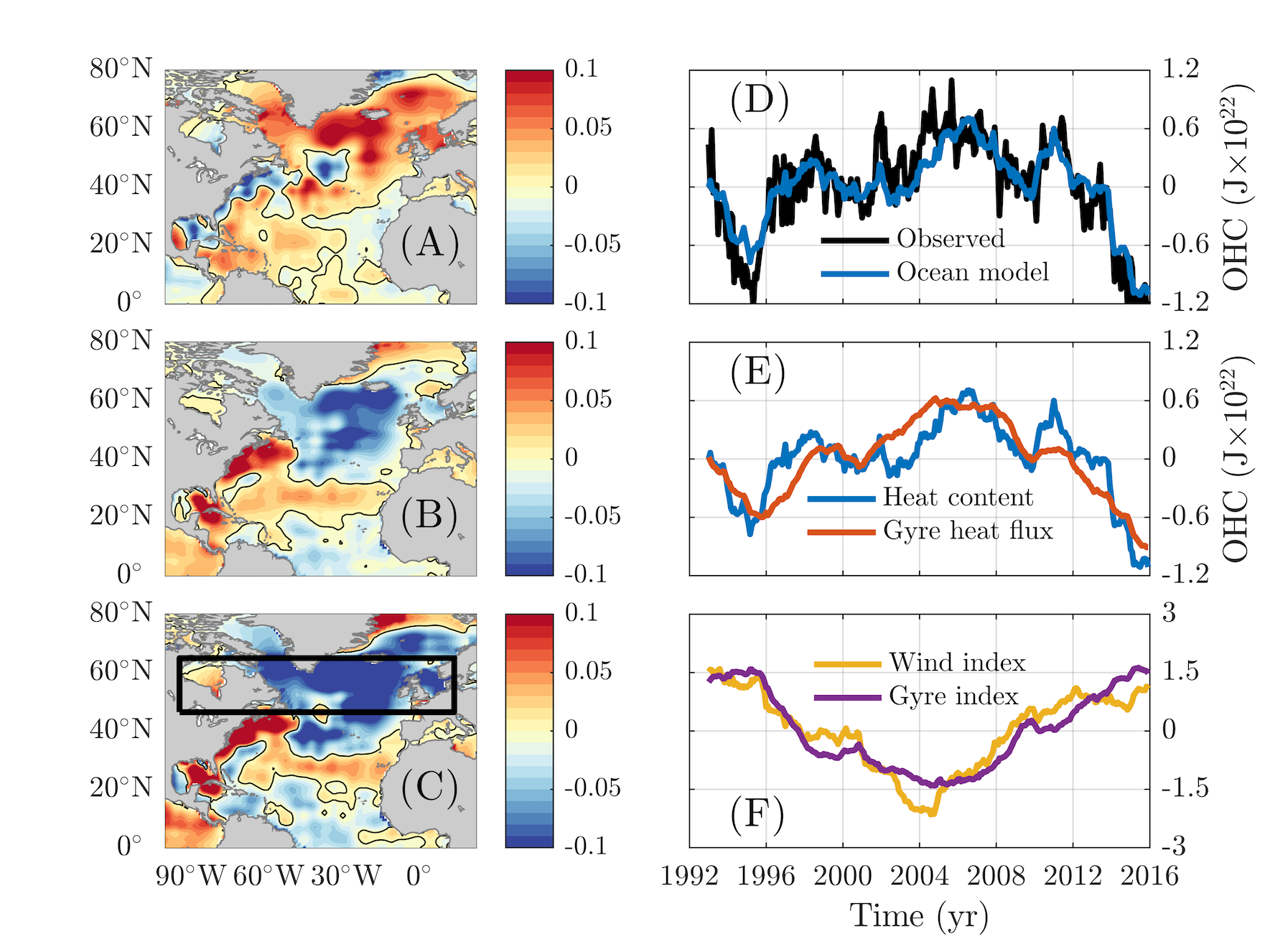What is responsible for recent decadal changes in the subpolar North Atlantic Ocean’s heat content?

Figure 1: Linear trend in observed [Good et al., 2013] ocean heat content (top 700 m; OHC) during (A) 1994-2004, (B) 2005-2015, and (C) the difference between (B) and (A). Units are °C per year. The thick black box outlined in (C) delineates the SPNA control volume (cf. (D), (E), (F)). (D) Full-depth OHC time series during 1993-2015 from observations (black) [Good et al., 2013] and the data-constrained ocean model (blue) [Forget et al., 2015] over the SPNA region (cf. black outlined box in (C)). (E) Modeled SPNA OHC (blue) versus the OHC changes due to variations in horizontal gyre circulation along the SPNA southern (midlatitude) boundary at 46°N (orange; cf. (C)). (F) Normalized indexes of the wind stress curl (yellow) and horizontal gyre circulation (purple) along the SPNA southern boundary at 46°N. These indexes represent the principle component time series based on a joint maximum covariance analysis of the model’s time-integrated horizontal gyre circulation and wind stress curl fields along this latitude.
The subpolar North Atlantic (SPNA) Ocean exhibits pronounced changes in temperature from one decade to the next (e.g., Schlesinger and Ramankutty, 1994). These SPNA decadal temperature fluctuations show strong correlation with other components of the climate system, for example, Atlantic hurricane activity, North American and European river flow, and rainfall over the African Sahel and northeast Brazil (Sutton and Hodson, 2005; Knight et al., 2006; Zhang and Delworth, 2006). Understanding the nature and predictability of decadal variability in SPNA temperatures has been a major goal in climate studies. Different hypotheses have been submitted to explain such decadal variability in climate models and data records, with appeals made variously to surface ocean forcing by local or remote wind stress and heat exchanges, as well as ocean heat transports by the vertical overturning and horizontal gyre circulations (Menary et al., 2015; Buckley and Marshall, 2016).
Over the last two decades, there has been a dramatic shift in oceanic climate over the SPNA. While there was a strong warming of the SPNA during 1994-2004, there has been a marked cooling of the region during the more recent 2005-2015 decade (Figure 1a-c) (Robson et al. 2016). To better understand the nature of this event, we considered an ocean circulation model constrained to most available ocean data (Forget et al., 2015). The model accurately reproduces observed changes in SPNA ocean heat content (Figure 1d). This striking SPNA decadal trend reversal from 1994-2004 to 2005-2015 arises in the model largely from variable heat transports by the ocean’s midlatitude horizontal gyre circulation (Figure 1e). What’s more, these fluctuations in ocean gyre circulation are strongly correlated with the local surface wind field (Figure 1f). These results imply that predictability of SPNA decadal changes is intimately tied to the predictability of the overlying atmosphere.
References
Buckley, M. W. and J. Marshall (2016), Observations, inferences, and mechanisms of Atlantic Meridional Overturning Circulation variability: A review, Rev. Geophys., 54, doi:10.1002/2015RG000493.
Forget, G., J.-M. Campin, P. Heimbach, C. N. Hill, R. M. Ponte, and C. Wunsch (2015), ECCO version 4: an integrated framework for non-linear inverse modeling and global ocean state estimation, Geosci. Model Dev., 8, 3071-3104.
Good, S. A., M. J. Martin and N. A. Rayner (2013), EN4: quality controlled ocean temperature and salinity profiles and monthly objective analyses with uncertainty estimates, J. Geophys. Res.-Oceans, 118, 6704-6716, doi:10.1002/2013JC009067.
Knight, J. R., C. K. Folland, and A. A. Scaife (2006), Climate impacts of the Atlantic Multidecadal Oscillation, Geophys. Res. Lett., 33, L17706, doi:10.1029/2006GL026242.
Menary, M. B., D. L. R. Hodson, J. I. Robson, R. T. Sutton, and R. A. Wood (2015), A Mechanism of Internal Decadal Atlantic Ocean Variability in a High-Resolution Coupled Climate Model, J. Climate, 28, 7764-7785.
Robson, J., P. Ortega, and R. Sutton (2016), A reversal of climatic trends in the North Atlantic since 2005 Nat. Geosci., 9, 513-517.
Schlesinger, M. E., and N. Ramankutty (1994), An oscillation in the global climate system of period 65-70 years, Nature, 367, 723-726.
Sutton, R. T., and D. L. R. Hodson (2005), Atlantic Ocean forcing of North American and European summer climate, Science, 309, 115-118.
Zhang, R., and T. L. Delworth (2006), Impacts of Atlantic multidecadal oscillations on India/Sahel rainfall and Atlantic hurricanes, Geophys. Res. Lett., 33, L17712, doi:10.1029/2006GL026267.
Summary written by Christopher Piecuch
************************************************************************************************************
Mechanisms underlying recent decadal changes in subpolar North Atlantic Ocean heat content
Christopher G. Piecuch, Rui M. Ponte, Christopher M. Little, Martha W. Buckley and Ichiro Fukumori
DOI: 10.1002/2017JC012845














Add new comment